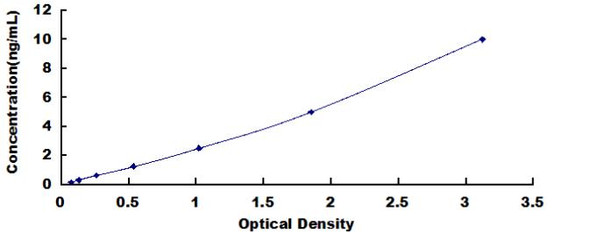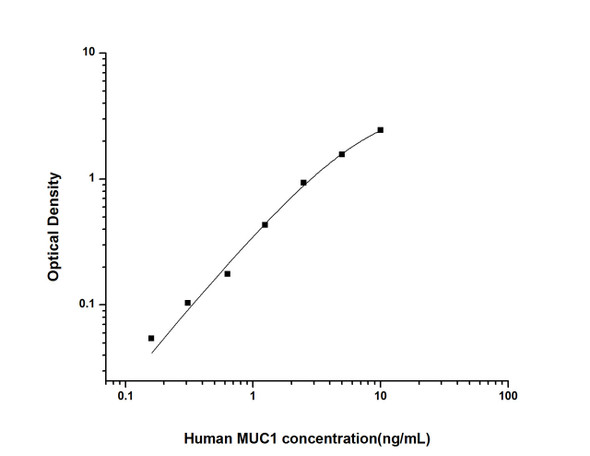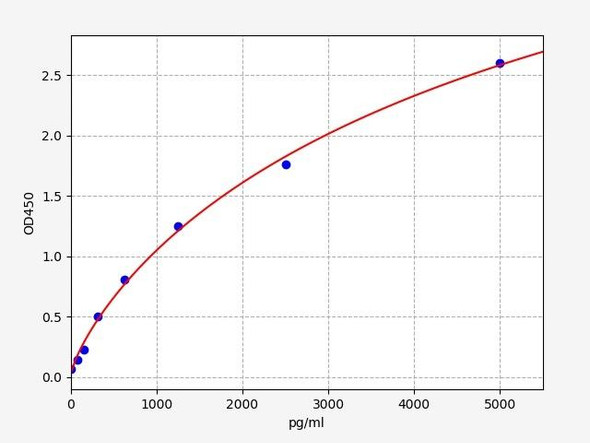Human Cell Biology ELISA Kits 3
Human MUC1 (Mucin 1) CLIA Kit (HUES00408)
- SKU:
- HUES00408
- Product Type:
- ELISA Kit
- ELISA Type:
- CLIA Kit
- Size:
- 96 Assays
- Sensitivity:
- 18.75pg/mL
- Range:
- 31.25-2000pg/mL
- ELISA Type:
- Sandwich
- Synonyms:
- CD227, EMA, H23AG, KL-6, MAM6, PEM, PEMT, PUM, CA 15-3
- Reactivity:
- Human
- Sample Type:
- Serum, plasma and other biological fluids
- Research Area:
- Cell Biology
Description
| Assay type: | Sandwich |
| Format: | 96T |
| Assay time: | 4.5h |
| Reactivity: | Human |
| Detection method: | Chemiluminescence |
| Detection range: | 31.25-2000 pg/mL |
| Sensitivity: | 18.75 pg/mL |
| Sample volume: | 100µL |
| Sample type: | Serum, plasma and other biological fluids |
| Repeatability: | CV < 15% |
| Specificity: | This kit recognizes Human MUC1 in samples. No significant cross-reactivity or interference between Human MUC1 and analogues was observed. |
This kit uses Sandwich-CLIA as the method. The micro CLIA plate provided in this kit has been pre-coated with an antibody specific to Human MUC1. Standards or samples are added to the appropriate micro CLIA plate wells and combined with the specific antibody. Then a biotinylated detection antibody specific for Human MUC1 and Avidin-Horseradish Peroxidase (HRP) conjugate are added to each micro plate well successively and incubated. Free components are washed away. The substrate solution is added to each well. Only those wells that contain Human MUC1, biotinylated detection antibody and Avidin-HRP conjugate will appear fluorescence. The Relative light unit (RLU) value is measured spectrophotometrically by the Chemiluminescence immunoassay analyzer. The RLU value is positively associated with the concentration of Human MUC1. The concentration of Human MUC1 in the samples can be calculated by comparing the RLU of the samples to the standard curve.
| UniProt Protein Function: | MUC1: a large cell surface glycoprotein expressed by most glandular and ductal epithelial cells and some hematopoietic cell lineages. Plays a role in adhesion and cell-cell interactions, metastasis and signaling. May provide a protective layer on epithelial surfaces. Direct or indirect interaction with actin cytoskeleton. Its cytoplasmic tail (MUC1CT) is involved in several signaling pathways, including those involving Ras, beta-catenin, p120 catenin, p53 and estrogen receptor alpha. MUC1CT also forms complexes with transcription factors, and then translocates to the nucleus by an unknown mechanism, where it is believed to influence the transcription of their target genes. MUC1CT has also been proposed to localize to mitochondrial membranes under conditions of genotoxic stress, where it attenuates the apoptotic pathway in response and confers resistance to apoptosis-inducing drugs. Aberrantly glycosylated forms expressed in human epithelial tumors, such as breast or ovarian cancer and also in non-epithelial tumor cells. Nine alternatively spliced isoforms have been described. Isoforms 5 and 9 are secreted. Isoform 7, expressed only in tumor cells, is a receptor and binds the secreted isoform 5. The binding induces the phosphorylation of the isoform 7, alters cellular morphology and initiates cell signaling. Can bind to GRB2 adapter protein. |
| UniProt Protein Details: | Protein type:Nuclear receptor co-regulator; Motility/polarity/chemotaxis; Actin-binding; Membrane protein, integral; Tumor suppressor; Cell adhesion Chromosomal Location of Human Ortholog: 1q21 Cellular Component: extracellular space; cell surface; integral to plasma membrane; Golgi lumen; cytoplasm; nuclear chromatin; apical plasma membrane; vesicle Molecular Function:protein binding; p53 binding; transcription cofactor activity Biological Process: protein amino acid O-linked glycosylation; DNA damage response, signal transduction by p53 class mediator resulting in transcription of p21 class mediator; cellular protein metabolic process; regulation of transcription from RNA polymerase II promoter in response to stress; O-glycan processing; post-translational protein modification; DNA damage response, signal transduction by p53 class mediator resulting in cell cycle arrest Disease: Medullary Cystic Kidney Disease 1 |
| NCBI Summary: | This gene encodes a membrane-bound protein that is a member of the mucin family. Mucins are O-glycosylated proteins that play an essential role in forming protective mucous barriers on epithelial surfaces. These proteins also play a role in intracellular signaling. This protein is expressed on the apical surface of epithelial cells that line the mucosal surfaces of many different tissues including lung, breast stomach and pancreas. This protein is proteolytically cleaved into alpha and beta subunits that form a heterodimeric complex. The N-terminal alpha subunit functions in cell-adhesion and the C-terminal beta subunit is involved in cell signaling. Overexpression, aberrant intracellular localization, and changes in glycosylation of this protein have been associated with carcinomas. This gene is known to contain a highly polymorphic variable number tandem repeats (VNTR) domain. Alternate splicing results in multiple transcript variants. [provided by RefSeq, Feb 2011] |
| UniProt Code: | P15941 |
| NCBI GenInfo Identifier: | 296439295 |
| NCBI Gene ID: | 4582 |
| NCBI Accession: | P15941. 3 |
| UniProt Secondary Accession: | P15941,P13931, P15942, P17626, A5YRV1, A6ZID9, A6ZIE0 B1AVQ8, B1AVR0, B6ECA1, E7ESE5, E7EUG9, |
| UniProt Related Accession: | P15941 |
| Molecular Weight: | |
| NCBI Full Name: | Mucin-1 |
| NCBI Synonym Full Names: | mucin 1, cell surface associated |
| NCBI Official Symbol: | MUC1 |
| NCBI Official Synonym Symbols: | EMA; MCD; PEM; PUM; KL-6; MAM6; MCKD; PEMT; CD227; H23AG; MCKD1; MUC-1; ADMCKD; ADMCKD1; CA 15-3; MUC-1/X; MUC1/ZD; MUC-1/SEC |
| NCBI Protein Information: | mucin-1; episialin; DF3 antigen; H23 antigen; cancer antigen 15-3; krebs von den Lungen-6; mucin 1, transmembrane; carcinoma-associated mucin; polymorphic epithelial mucin; peanut-reactive urinary mucin; tumor associated epithelial mucin; breast carcinoma-associated antigen DF3; tumor-associated epithelial membrane antigen; Medullary cystic kidney disease, autosomal dominant |
| UniProt Protein Name: | Mucin-1 |
| UniProt Synonym Protein Names: | Breast carcinoma-associated antigen DF3; Cancer antigen 15-3; CA 15-3; Carcinoma-associated mucin; Episialin; H23AG; Krebs von den Lungen-6; KL-6; PEMT; Peanut-reactive urinary mucin; PUM; Polymorphic epithelial mucin; PEM; Tumor-associated epithelial membrane antigen; EMA; Tumor-associated mucin; CD_antigen: CD227Cleaved into the following 2 chains:Mucin-1 subunit alpha; MUC1-NT; MUC1-alpha; Mucin-1 subunit beta; MUC1-betaAlternative name(s):MUC1-CT |
| Protein Family: | Mucin |
| UniProt Gene Name: | MUC1 |
| UniProt Entry Name: | MUC1_HUMAN |
As the RLU values of the standard curve may vary according to the conditions of the actual assay performance (e. g. operator, pipetting technique, washing technique or temperature effects), the operator should establish a standard curve for each test. Typical standard curve and data is provided below for reference only.
| Concentration (pg/mL) | RLU | Average | Corrected |
| 2000 | 53825 57617 | 55721 | 55693 |
| 1000 | 22624 25324 | 23974 | 23946 |
| 500 | 11863 10201 | 11032 | 11004 |
| 250 | 5063 5525 | 5294 | 5266 |
| 125 | 2683 2533 | 2608 | 2580 |
| 62.5 | 1322 1300 | 1311 | 1283 |
| 31.25 | 651 697 | 674 | 646 |
| 0 | 27 29 | 28 | -- |
Precision
Intra-assay Precision (Precision within an assay): 3 samples with low, mid range and high level Human MUC1 were tested 20 times on one plate, respectively.
Inter-assay Precision (Precision between assays): 3 samples with low, mid range and high level Human MUC1 were tested on 3 different plates, 20 replicates in each plate.
| Intra-assay Precision | Inter-assay Precision | |||||
| Sample | 1 | 2 | 3 | 1 | 2 | 3 |
| n | 20 | 20 | 20 | 20 | 20 | 20 |
| Mean (pg/mL) | 94.57 | 299.67 | 967.40 | 103.18 | 278.23 | 1041.74 |
| Standard deviation | 10.74 | 35.03 | 76.33 | 9.53 | 24.15 | 114.70 |
| C V (%) | 11.36 | 11.69 | 7.89 | 9.24 | 8.68 | 11.01 |
Recovery
The recovery of Human MUC1 spiked at three different levels in samples throughout the range of the assay was evaluated in various matrices.
| Sample Type | Range (%) | Average Recovery (%) |
| Serum (n=5) | 92-105 | 99 |
| EDTA plasma (n=5) | 98-111 | 105 |
| Cell culture media (n=5) | 86-98 | 92 |
Linearity
Samples were spiked with high concentrations of Human MUC1 and diluted with Reference Standard & Sample Diluent to produce samples with values within the range of the assay.
| Serum (n=5) | EDTA plasma (n=5) | Cell culture media (n=5) | ||
| 1:2 | Range (%) | 94-110 | 99-116 | 88-102 |
| Average (%) | 101 | 106 | 93 | |
| 1:4 | Range (%) | 88-100 | 86-101 | 87-103 |
| Average (%) | 94 | 93 | 95 | |
| 1:8 | Range (%) | 95-108 | 90-102 | 87-100 |
| Average (%) | 101 | 96 | 94 | |
| 1:16 | Range (%) | 90-105 | 89-103 | 96-110 |
| Average (%) | 97 | 95 | 102 |
An unopened kit can be stored at 4°C for 1 month. If the kit is not used within 1 month, store the items separately according to the following conditions once the kit is received.
| Item | Specifications | Storage |
| Micro CLIA Plate(Dismountable) | 8 wells ×12 strips | -20°C, 6 months |
| Reference Standard | 2 vials | |
| Concentrated Biotinylated Detection Ab (100×) | 1 vial, 120 µL | |
| Concentrated HRP Conjugate (100×) | 1 vial, 120 µL | -20°C(shading light), 6 months |
| Reference Standard & Sample Diluent | 1 vial, 20 mL | 4°C, 6 months |
| Biotinylated Detection Ab Diluent | 1 vial, 14 mL | |
| HRP Conjugate Diluent | 1 vial, 14 mL | |
| Concentrated Wash Buffer (25×) | 1 vial, 30 mL | |
| Substrate Reagent A | 1 vial, 5 mL | 4°C (shading light) |
| Substrate Reagent B | 1 vial, 5 mL | 4°C (shading light) |
| Plate Sealer | 5 pieces | |
| Product Description | 1 copy | |
| Certificate of Analysis | 1 copy |
- Set standard, test sample and control (zero) wells on the pre-coated plate and record theirpositions. It is recommended to measure each standard and sample in duplicate. Note: addall solutions to the bottom of the plate wells while avoiding contact with the well walls. Ensuresolutions do not foam when adding to the wells.
- Aliquot 100µl of standard solutions into the standard wells.
- Add 100µl of Sample / Standard dilution buffer into the control (zero) well.
- Add 100µl of properly diluted sample (serum, plasma, tissue homogenates and otherbiological fluids. ) into test sample wells.
- Cover the plate with the sealer provided in the kit and incubate for 90 min at 37°C.
- Aspirate the liquid from each well, do not wash. Immediately add 100µL of BiotinylatedDetection Ab working solution to each well. Cover the plate with a plate seal and gently mix. Incubate for 1 hour at 37°C.
- Aspirate or decant the solution from the plate and add 350µL of wash buffer to each welland incubate for 1-2 minutes at room temperature. Aspirate the solution from each well andclap the plate on absorbent filter paper to dry. Repeat this process 3 times. Note: a microplatewasher can be used in this step and other wash steps.
- Add 100µL of HRP Conjugate working solution to each well. Cover with a plate seal andincubate for 30 min at 37°C.
- Aspirate or decant the solution from each well. Repeat the wash process for five times asconducted in step 7.
- Add 100µL of Substrate mixture solution to each well. Cover with a new plate seal andincubate for no more than 5 min at 37°C. Protect the plate from light.
- Determine the RLU value of each well immediately.






